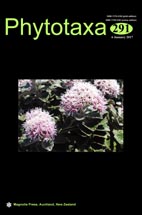Abstract
In 1906, Clarke described C. hypsipedos based on specimens of Weberbauer 2617 and placed this species in subgenus Vignea. In 1909, Kükenthal also described the name C. umbellata var. depressa on the basis of the number Weberbauer 2617, a species attributed to section Acrocystis of subgenus Carex. Wheeler in 1988 also placed C. hypsipedos in section Acrocystis while reducing Kükenthal’s name to synonymy. During a recent herbarium survey, we studied syntypes corresponding to Weberbauer 2617 at B, F, G, and MOL. The study of these materials revealed important inconsistencies between the specimens and Clarke’s protologue and Wheeler’s study, suggesting that Weberbauer 2617 is a mixed collection of two different species. One plant conforms to Carex sect. Acrocystis, while the other bears resemblance to subgenus Vignea. Several salient characters distinguish these two taxa from each other, most notably including: stigmas 3 vs. stigmas 2, achenes trigonous vs. lenticular, and perigynium pubescent to puberulent vs. glabrous. Carex hypsipedos from Peru, corresponding to Clarke’s original description, is here lectotypified. The Carex sect. Acrocystis species is assigned a new name, Carex punicola, from Argentina, Bolivia, and Peru (South America). In addition to Wheeler’s (1988) observations, we here provide additional detail and illustration of this species. It is closely related to C. geophila, another American species in section Acrocystis.

